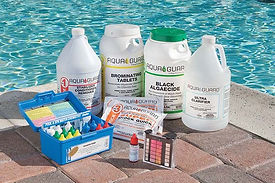Understanding Pool Water Chemistry

Pool water chemistry can be complex, and condensing everything into a single blog post is nearly impossible. However, I’ll cover the basics to give you a solid understanding. There are nine key chemicals or chemical classes that need to be regularly tested and adjusted in a pool. For brevity, we’ll focus on the three most important ones: pH, alkalinity, and chlorine.
1. pH: The Foundation of Pool Chemistry (Ideal range: 7.2 – 7.8)
pH is one of the most critical factors in pool water balance. If it's too high or too low, it can cause skin and eye irritation and even damage expensive pool components like heaters and plaster. Additionally, pH directly affects chlorine efficiency—the higher the pH, the less effective your chlorine becomes.
· To raise pH: Add sodium carbonate (often sold as “pH Up”).
· To lower pH: Use muriatic acid or sodium bisulfate (dry acid), though dry acid is generally not recommended for a few reasons.
2. Alkalinity: The pH Stabilizer (Ideal range: 80 – 120 ppm)
If you’re wondering how to keep pH stable, the answer is alkalinity. More specifically, total alkalinity acts as a buffer, preventing drastic swings in pH.
· To lower alkalinity: Use muriatic acid.
· To raise alkalinity: Add sodium bicarbonate (baking soda—yes, the same stuff in your kitchen!).
Maintaining proper alkalinity helps prevent pH fluctuations, which in turn keeps your pool water comfortable and your chlorine working efficiently.
3. Chlorine: The Pool’s Primary Sanitizer (Ideal range: 3 – 5 ppm)
Chlorine is essential for keeping your pool free of bacteria, algae, and other contaminants. While chlorine levels technically need to be 7.5% of the stabilizer (cyanuric acid) level, most pool owners find it easier to maintain between 3 and 5 ppm.
You can add chlorine in several forms:
· Liquid chlorine (sodium hypochlorite) – Often mistakenly referred to as "bleach".
· Trichlor (granular or tablet form)
· Dichlor
· Gas chlorine (used in commercial pools)
· Calcium hypochlorite (cal hypo)
· Salt system (my favorite!) – Converts salt into chlorine through a chemical process,
providing a steady and consistent chlorine level.
Want to Know More?
There’s a lot more to pool chemistry, but this quick basic training should help you better understand the numbers on your weekly pool service report.
If you’re in the Temecula Valley and want expert pool service, click here to get Grade A service from Pool Nerds!
